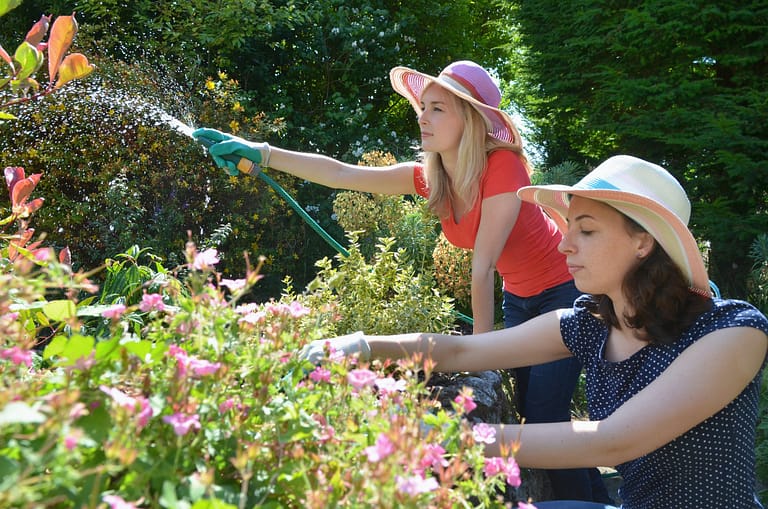Xeriscaping: The Future of Dallas Gardens
Are you tired of spending too much time and effort on watering and maintaining your garden? Let me introduce you to xeriscaping, which is the future of gardens in Dallas.
It's all about creating beautiful, low-maintenance landscapes that thrive in our hot, dry climate. With xeriscaping, you can save up to 60% on water usage, reduce labor, and support native plant species.
By using efficient irrigation systems and native plants, you'll not only save money but also contribute to environmental conservation. Xeriscaping is more than just a trend; it's a sustainable lifestyle, and Dallas is at the forefront of this movement.
Join us and transform your garden into a sustainable oasis.
Key Takeaways
Are you tired of spending excessive time and effort on watering and maintaining your garden? Let me introduce you to xeriscaping, which is the future of gardens in Dallas.
Xeriscaping focuses on creating beautiful, low-maintenance landscapes that thrive in our hot, dry climate. By using efficient irrigation systems and native plants, you can save up to 60% on water usage, reduce labor, and support native plant species. This not only saves money but also contributes to environmental conservation.
Xeriscaping is not just a passing trend; it's a sustainable lifestyle, and Dallas is leading this movement. Join us in transforming your garden into a sustainable oasis.
What Is Xeriscaping
Xeriscaping is a method of landscaping that aims to create a garden that uses less water and requires minimal maintenance. By using native and adaptive plants, xeriscaping can reduce water usage by up to 60%. This approach is especially important in places like Texas, where water conservation is crucial.
By choosing plants that are well-suited to the local climate, xeriscaping minimizes the need for excessive watering, ultimately helping to conserve water resources. Not only does xeriscaping benefit the environment, but it also lowers water bills for homeowners. It allows people to enjoy the natural beauty of Texas while being mindful of water usage.
Benefits of Xeriscaping
Xeriscaping has several benefits for homeowners.
It helps in reducing water usage, lowering maintenance needs, and improving property value. By using xeriscape design, you can decrease irrigation water usage by up to 60%, leading to significant savings on water bills. This approach not only saves water but also contributes to environmental sustainability by reducing overall water consumption.
Additionally, xeriscaping promotes the use of native plants, which thrive in the local climate and need minimal watering once they're established. The decreased maintenance requirements make it an excellent landscaping option, supporting healthier soil through mulching.
Ultimately, xeriscaping enhances a property's resilience during drought seasons and boosts its overall value, providing long-term benefits for homeowners.
Water Conservation in Dallas Gardens
Water conservation in Dallas gardens is crucial for preserving the local ecosystem and minimizing water waste. To achieve this, it's essential to focus on implementing efficient irrigation systems and grouping plants with similar water needs. Here are some practical tips for water conservation in Dallas gardens:
- Use Drip Irrigation Systems: Installing drip irrigation systems delivers water directly to the roots, reducing evaporation and water waste.
- Choose Texas Native and Low Maintenance Plants: Opt for plants suited to the local climate, such as Texas native and low maintenance plants, to reduce the need for excessive watering.
- Group Plants with Similar Water Requirements: Grouping plants with similar water needs together ensures efficient water usage and prevents overwatering.
Incorporating xeriscaping principles into your garden not only promotes water conservation but also creates a sustainable and thriving ecosystem. By following these innovative approaches, you can contribute to the overall effort of water conservation in Dallas gardens while enjoying a beautiful and sustainable landscape.
Xeriscaping Techniques
Implementing xeriscaping techniques in your Dallas garden requires efficient irrigation systems. The climate in Texas necessitates water-efficient landscaping, and xeriscaping achieves this by using native plants grouped according to their water needs. Incorporating native plants not only reduces water usage but also supports the local ecosystem.
Additionally, consider soil amendments like mulch to enhance water retention and soil quality, promoting plant health. Understanding the water needs of different plant species allows you to create a balanced and sustainable garden that conserves water.
Xeriscaping isn't just about saving water; it's a way to embrace the natural beauty of Texas while conserving precious resources. With the right techniques, you can create a vibrant and thriving garden that complements the Texas landscape.
Native Plants for Dallas Xeriscaping
When xeriscaping in Dallas, consider using native plants like agave, red yucca, and Texas frog fruit. These plants are well-suited to the local climate and require minimal water.
Grouping these plants based on their water and sunlight needs will help you create a water-efficient and visually appealing landscape.
By incorporating adaptable plants from diverse regions, you can enhance biodiversity and create a unique xeriscape design for your Dallas garden.
This approach not only conserves water but also supports the local ecosystem, making it an environmentally friendly choice for landscaping in Dallas.
Ideal Native Plants
When planning a xeriscaping project in Dallas, it's important to choose native plants that thrive in the local climate. These plants are well-suited to the central Texas region, needing less water and maintenance while still creating a beautiful and resilient landscape.
Here are some great native plant options for your xeriscaped yard:
- Agave: This succulent plant is perfect for xeriscaping because it requires minimal water and has a striking architectural form.
- Red Yucca: With its tall spikes of coral-colored flowers, this plant adds a vibrant touch to your xeriscaped yard while being drought-tolerant.
- Texas Frog Fruit: This groundcover plant not only needs little water but also attracts pollinators, benefiting the local ecosystem.
Water-Efficient Landscaping
Creating a water-efficient xeriscape in your Dallas garden involves using native Texas plants that thrive in the local climate and need minimal maintenance. These plants, such as abelia, liriope, and dwarf yaupon holly, are well-suited to the environment and require less water.
It's important to group these plants based on their water and sunlight needs to help them grow effectively. Additionally, consider integrating drip irrigation systems to deliver water efficiently to your plants and minimize wastage.
By strategically placing these water-efficient plants and incorporating drip irrigation, you can save water while maintaining a vibrant landscape. This approach not only benefits the environment but also reduces the need for extensive maintenance, making it a practical choice for your Dallas garden.
Embracing water-efficient landscaping with native Texas plants promotes a sense of belonging and responsibility to the local ecosystem.
Implementing Xeriscaping in Dallas
When you xeriscape in Dallas, you can enjoy the benefits of conserving water and selecting from various drought-resistant plant options that thrive in the North Texas climate.
By using efficient irrigation systems and grouping plants with similar water needs, you can create a sustainable and visually appealing landscape that requires minimal water resources.
It's important to consider using native and adaptive plants such as agave, red yucca, and Texas frog fruit to conserve water and enhance your garden's resilience.
Water Conservation Benefits
Water conservation is crucial, and xeriscaping in Dallas offers a practical way to achieve this.
By using xeriscaping, you can enjoy several benefits that help conserve water and promote sustainable gardening practices in the area.
Firstly, selecting plants that are native or adaptive to the region's climate reduces the need for extensive watering, potentially cutting water usage by up to 60%. This not only saves money on water bills but also encourages responsible water consumption for maintaining a vibrant landscape.
Additionally, creating a landscape with efficient drainage not only prevents water wastage but also fosters healthy plant growth. By avoiding exotic plants that demand excessive watering and choosing those with similar water requirements, you contribute to preserving local ecosystems and promoting the overall well-being of Dallas gardens.
These practices not only enhance the environment but also make gardening more manageable, saving time and effort on maintenance tasks.
Drought-Resistant Plant Options
Choosing plants that can withstand drought is essential for xeriscaping in Dallas gardens. When picking plants for xeriscaping, look for ones that need minimal water to thrive. It's best to select plants native to the region or those that have adapted to the climate because they generally require less water to grow.
Grouping plants with similar water needs together is also beneficial as it promotes efficient water usage and improves irrigation. Some great drought-resistant plant options for xeriscaping in Dallas include agave, red yucca, Texas frog fruit, abelia, liriope, and dwarf yaupon holly.
Frequently Asked Questions
What Are 2 Disadvantages of Using Xeriscaping in Landscaping?
Xeriscaping in landscaping can limit the variety of plants, which affects the visual appeal and ecosystem support. Although maintenance is low, the initial investment in soil and plants can be costly. It's important to consider both the environmental impact and aesthetic appeal when opting for xeriscaping.
Why Is Xeriscape so Expensive?
Xeriscape may seem costly at first because of the initial expenses and design choices. However, it offers long-term benefits such as water conservation, lower maintenance needs, and a positive impact on the environment. The investment in xeriscaping pays off over time due to these reasons.
Does Xeriscaping Increase or Decrease?
Xeriscaping offers both water conservation and lower maintenance, making it a beneficial choice. This landscaping method positively impacts the environment, reduces water bills, and promotes healthier soil. However, some individuals may miss the lush appearance of traditional landscaping. It's important to carefully consider these factors before making a decision.
Is Xeriscaping Landscaping That Reduces Water Usage?
Yes, xeriscaping is a type of landscaping that helps reduce water usage. This method is beneficial for the environment as it conserves water and also offers various design options. In addition, xeriscaping promotes native plants, making it a sustainable and practical choice for your garden due to its drought resistance and low maintenance requirements. Overall, xeriscaping is an excellent way to create a beautiful and eco-friendly outdoor space.







